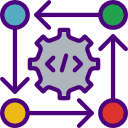No-code solutions have redefined how organizations approach digital transformation, making it possible for businesses of all sizes to optimize and automate their processes efficiently. By eliminating the barriers imposed by traditional software development, no-code platforms empower both technical and non-technical teams to design, implement, and refine workflows swiftly. This new approach accelerates innovation and reduces the time and cost associated with business process improvements, fostering agility in an increasingly competitive landscape.
Empowering Employees to Innovate
Citizen Development at Scale
Citizen development refers to empowering employees without formal coding skills to build their own digital tools. No-code solutions make it possible for those closest to the business challenge to create and test solutions rapidly. This approach not only reduces bottlenecks in IT departments but also results in tools that are tailored precisely to users’ needs. The result is a culture where innovation is decentralized, leading to a continuous flow of incremental improvements across the organization.
Accelerating Workflow Optimization
Traditional business process optimization often requires significant resources, long timelines, and extensive technical expertise. No-code platforms change this dynamic by equipping employees to map out and automate repetitive tasks, data flows, or approval processes in real time. Rapid prototyping and instant deployment shorten the feedback loop, allowing for continuous refinement and optimization of workflows with minimal disruption to daily operations.
Reducing Reliance on IT
One persistent challenge in many organizations is the backlog of IT requests for custom integrations, application updates, or process automations. No-code solutions alleviate this pressure by providing user-friendly interfaces and intuitive logic builders, enabling business users to implement changes independently. This not only frees up IT teams for more complex strategic initiatives but also dramatically accelerates the overall pace of digital transformation within the company.
Enhancing Agility and Responsiveness
With traditional software development, even basic prototypes can take weeks or months to develop and test. In contrast, no-code platforms allow businesses to quickly translate ideas into working prototypes. Stakeholders can interact with these prototypes, provide feedback, and see modifications in real time, significantly reducing the development cycle. This iterative process ensures that final solutions closely align with user needs and business objectives.
As regulations, customer expectations, and market conditions evolve, organizations must be ready to pivot processes or introduce new tools with minimal delay. No-code solutions facilitate swift changes by allowing process owners to adapt workflows, adjust forms, or create new automations without depending on lengthy development timelines. This capability to respond rapidly strengthens a business’s competitive edge and reduces downtime during transitions.
Business processes often span multiple departments, requiring cohesive solutions that bring together diverse teams. No-code tools provide shared platforms where team members from different functions can collaborate on designing, testing, and deploying workflows. By breaking down silos and promoting transparency, these platforms encourage input from all stakeholders, leading to more robust and effective process solutions.
Driving Business Growth and Efficiency
Automating Repetitive Tasks
Manual, repetitive tasks consume valuable employee time and are prone to human error. No-code platforms allow businesses to automate these processes—such as data entry, report generation, notifications, and approvals—seamlessly. This not only improves productivity and accuracy but also enhances employee satisfaction by freeing them to focus on higher-value activities.


Improving Data Management
Data silos and inconsistencies often hinder effective decision-making. No-code solutions enable organizations to connect disparate data sources and establish centralized repositories without complex integrations. Enhanced data flows and automated validation ensure that the information driving business decisions is accurate, up-to-date, and easily accessible, supporting better outcomes at every level of the organization.
Join our mailing list
